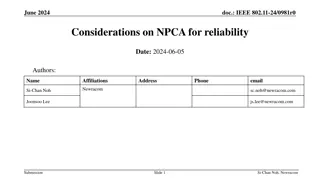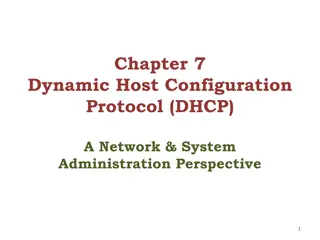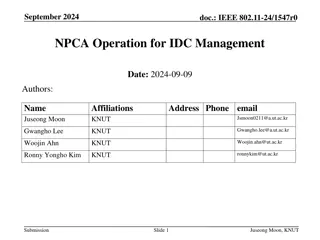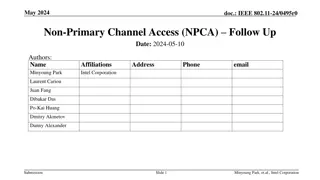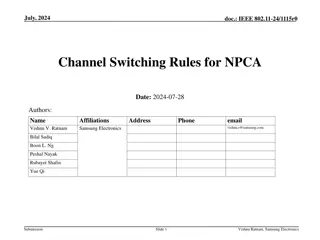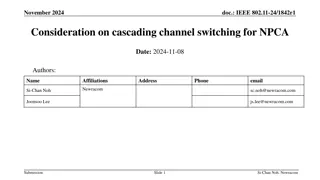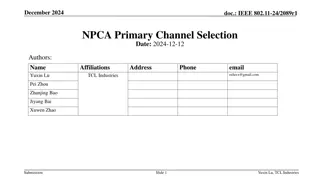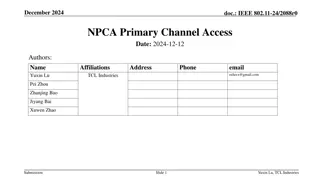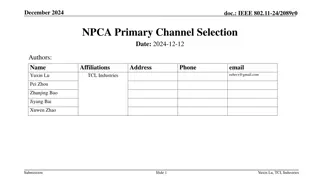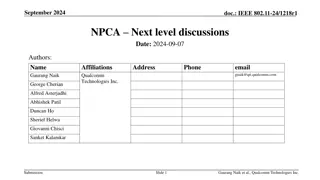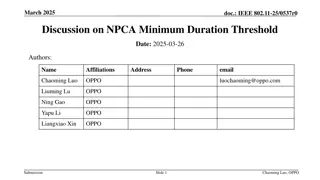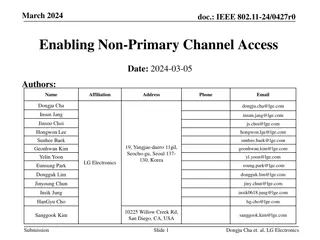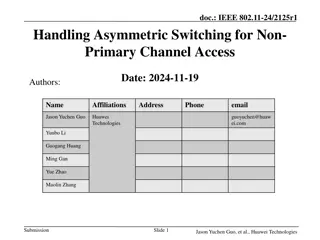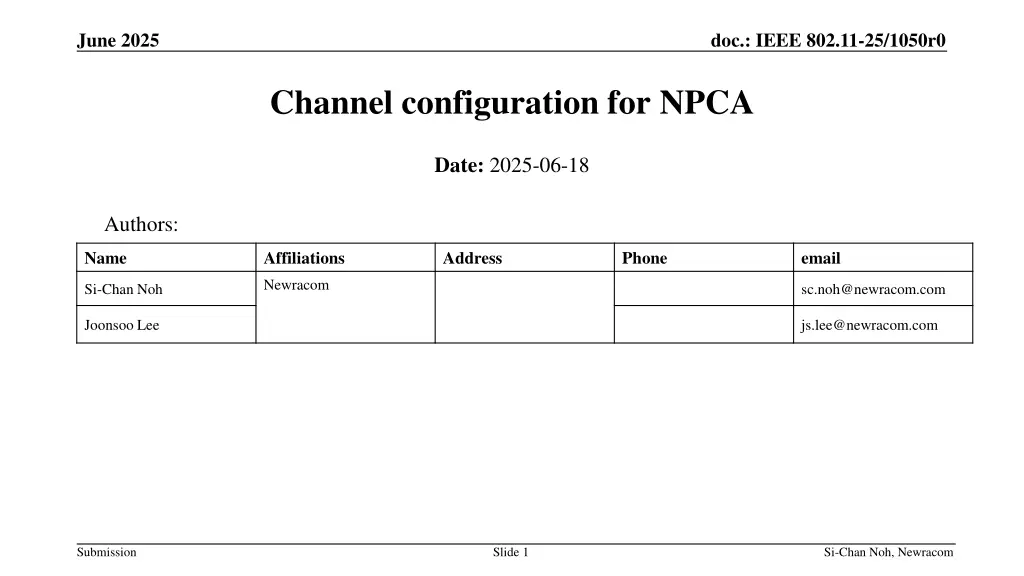
Channel Configuration Update for Improved Efficiency
Discussing the update of channel configuration parameters through the NPCA Operation Information field to enhance efficiency and avoid ambiguity between NPCA STAs. Exploring the designated NPCA p-channel within the BSS bandwidth to optimize NPCA operation and primary segment definition based on its location within S80 or S160. Addressing potential ambiguity and bandwidth utilization strategies for NPCA STAs to prevent misinterpretation and enhance performance during operation.
Uploaded on | 0 Views
Download Presentation

Please find below an Image/Link to download the presentation.
The content on the website is provided AS IS for your information and personal use only. It may not be sold, licensed, or shared on other websites without obtaining consent from the author. If you encounter any issues during the download, it is possible that the publisher has removed the file from their server.
You are allowed to download the files provided on this website for personal or commercial use, subject to the condition that they are used lawfully. All files are the property of their respective owners.
The content on the website is provided AS IS for your information and personal use only. It may not be sold, licensed, or shared on other websites without obtaining consent from the author.
E N D
Presentation Transcript
June 2025 doc.: IEEE 802.11-25/1050r0 Channel configuration for NPCA Date: 2025-06-18 Authors: Name Affiliations Address Phone email Newracom Si-Chan Noh sc.noh@newracom.com Joonsoo Lee js.lee@newracom.com Submission Slide 1 Si-Chan Noh, Newracom
June 2025 doc.: IEEE 802.11-25/1050r0 Introduction In this contribution, we discuss updating channel configuration parameters through the NPCA Operation Information field to avoid potential ambiguity between NPCA STAs and improve bandwidth efficiency Submission Slide 2 Si-Chan Noh, Newracom
June 2025 doc.: IEEE 802.11-25/1050r0 Potential ambiguity / BW efficiency (1/3) The NPCA p-channel is designated channel within the BSS BW to enable NPCA operation and after switching to the NPCA p-channel, if NPCA STAs obtain TXOP on this channel, the BW including NPCA p-channel can serve as the primary segment This primary segment can be defined based on where the NPCA p-channel is located When considering an OPBW 320 MHz, the primary segment during NPCA operation may vary depending on whether the NPCA p-channel is located within an S80 or S160 <NPCA p-channel within an S80> <NPCA p-channel within an S160> S160 S160 P80 P20 P80 S80 S80 P20 BSS channel configuration NPCA channel configuration BSS channel configuration NPCA channel configuration P80 P80 P20 P20 Submission Slide 3 Si-Chan Noh, Newracom
June 2025 doc.: IEEE 802.11-25/1050r0 Potential ambiguity / BW efficiency (2/3) However, following a channel configuration based only on the primary segment including the NPCA p-channel may lead to ambiguity between NPCA STAs For example, NPCA AP and NPCA non-AP STAs may interpret the secondary segment differently To prevent malfunction due to misaligned channel segments between NPCA STAs, explicitly sharing the full channel configuration can resolve these ambiguity issues Moreover, it can offer advantages if the explicit configuration is designed in a bandwidth- efficient manner A simple method is to configure the full channel allocation across the BSS BW to enable the use of a larger BW during NPCA operation By enabling the user of larger BW, when the NPCA AP advertises the NPCA disabled subchannel bitmap which contains information about punctured subchannels, the number of candidate of subchannels available for puncturing may increase For example, when operating an NPCA BSS with a 320 MHz BW, there is an additional 160 MHz margin compared to operating it at 160 MHz, and by applying puncturing depending on the channel conditions, a wider NPCA BSS BW can be utilized. Submission Slide 4 Si-Chan Noh, Newracom
June 2025 doc.: IEEE 802.11-25/1050r0 Potential ambiguity / BW efficiency (3/3) Case 1 and Case 2 represent different interpretations of the secondary segment depending on whether the NPCA p-channel is in S80 or S160 In both scenarios, interpreting the channel as Case 2 is more advantageous than Case 1 because it can utilize a larger BW Therefore, it is necessary to explicitly share the channel configuration so that after the NPCA STA switches to the NPCA p-channel, the channel configuration operates according to Case 2 One way to explicitly share the configuration is to reuse parameters such as CCFS0 and CCFS1 These parameters can be included in the NPCA Operation Information field Case 1 Case 2 Case 1 Case 2 Unused Unused S80 S160 S160 S160 P80 S80 P80 P20 S80 P80 S80 S80 P80 P20 S160 BSS channel configuration NPCA channel configuration BSS channel configuration NPCA channel configuration P80 P80 S80 P20 P20 Submission Slide 5 Si-Chan Noh, Newracom
June 2025 doc.: IEEE 802.11-25/1050r0 Offering channel configuration parameters (1/2) Proposal : Including NPCA CCFS0/CCFS1 in the NPCA Operation Information field NPCA CCFS1 (8 bits) NPCA CCFS0 (8 bits) NPCA Operation Information field format with added subfield NPCA CCFS0 and NPCA CCFS1 NPCA CCFS0/CCFS1 subfield : Subfield Encoding For 80 MHz NPCA BSS BW, indicates the channel center frequency index of 80 MHz channel For 160 MHz NPCA BSS BW, indicates the channel center frequency index of the primary 80 MHz For 320 MHz NPCA BSS BW, indicates the channel center frequency index of the primary 160 MHz NPCA CCFS0 For 80 MHz NPCA BSS BW, this subfield is set to 0 For 160 MHz NPCA BSS BW, indicates the channel center frequency index of 160 For 320 MHz NPCA BSS BW, indicates the channel center frequency index of 320 NPCA CCFS1 Submission Slide 6 Si-Chan Noh, Newracom
June 2025 doc.: IEEE 802.11-25/1050r0 Offering channel configuration parameters (2/2) If the NPCA AP and non-AP STA use NPCA CCFS0/CCFS1 along with the NPCA p-channel and set these parameters to optimize BW efficiency, they can clarify the channel configuration and operate unambiguously while enhancing spectrum utilization For example, if the NPCA operation is intended to follow the channel configuration shown below (i.e., the desired configuration), this can be achieved via NPCA CCFS1/CCFS0 (desired) NPCA CCFS1 S160 S160 S160 S160 NPCA CCFS0 S80 P80 S80 P80 P20 P20 BSS channel configuration NPCA channel configuration BSS channel configuration NPCA channel configuration P80 S80 P80 S80 P20 P20 Submission Slide 7 Si-Chan Noh, Newracom
February 2025 doc.: IEEE 802.11-25/1050r0 Summary In this presentation, by explicitly sharing channel configuration parameters, potential ambiguities in NPCA operation can be resolved Furthermore, if the explicit channel configuration is determined in a bandwidth-efficient manner, it has been shown that NPCA operation can take place over a larger BW during the NPCA period Submission Slide 8 Si-Chan Noh, Newracom







